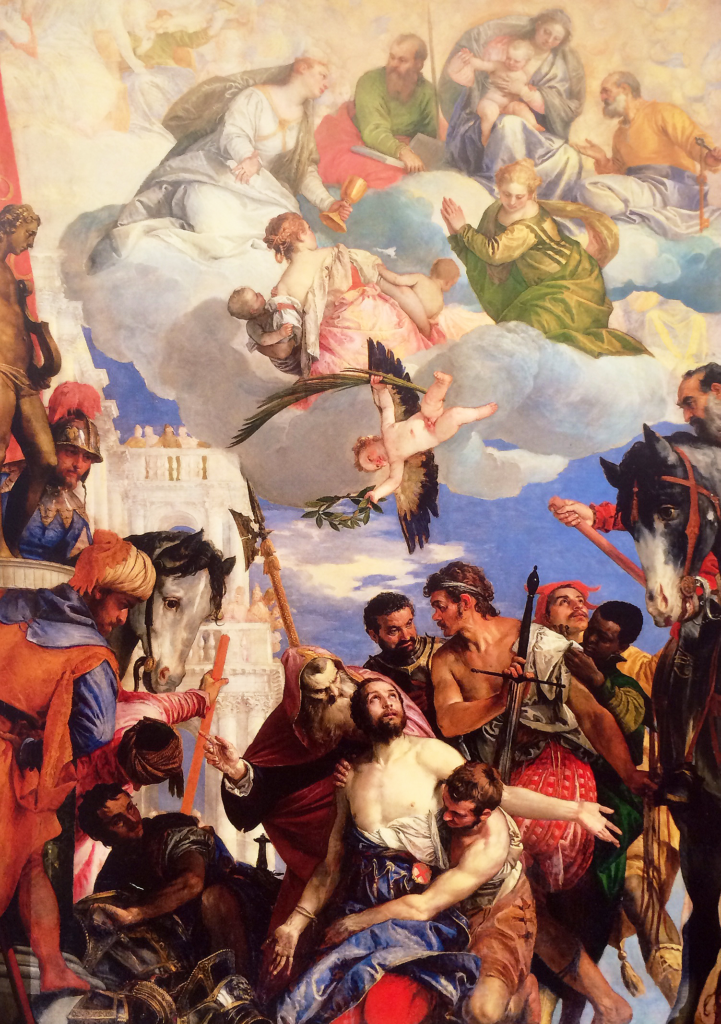
In March 2014 I attended the National Gallery in London to see: Veronese, Magnificence in Renaissance Venice. The exhibit itself was fantastic and something I am delighted to have seen in person. In my last post, I took a detailed look at the first painting I saw in the exhibition – The Raising of the Daughter of Jairus and in this post I am going to take a closer look at my favourite, The Martyrdom of Saint George.
For me, the St George was the stand out piece from the exhibition and quite simply the most breath-taking painting I have seen in person to date. I do not think for one minute that I will be able to do the painting justice in this post or accurately portray the feelings felt in it’s presence but I will try to provide some understanding behind the painting’s history, style and composition.
I am extremely pleased in the knowledge that for the rest of my days I can say…“I have seen one of the greatest paintings to have emerged from one of the greatest artists of The Venetian Renaissance”. If you ever get the chance to see this incredible painting then I would strongly recommend that you take it
Overview
Name: The Martyrdom of Saint George
Artist: Paolo Veronese (1528 – 1588)
Date Painted: circa 1565
Period: Renaissance Venice
Dimensions: 431.3 cm (h) x 300.4 cm (w)
Medium / Material: Oil on canvas
Current Location: San Giorgio in Braida, Verona
Other: Featured in the Veronese exhibition at the National Gallery, 2014
Introduction to The Martyrdom of Saint George
During the 1550s, the high altar of the San Giorgio, Verona underwent changes which were headed by celebrated Venetian architect and mentor of Veronese , Michele Sanmichele. A decade earlier (1540), Sanmichele architected the dome for the structure but his death in 1558 meant that he would not be able to complete the altar – the work was taken up by Bernardino Brugnoli and completed in 1564. It is believed that Veronese’s participation in the commission would have been arranged through his connections to Sanmicheli but the untimely death would have prolonged the work until completion of the high altar.
It is believed that the painting may have been commissioned to replace the work of Givanni Francesco Caroto, 1535, which depicted the well known legend of Saint George slaying the dragon to save the princess from imminent death. The painting can be seen below and it is fair to say that there are some clear parallels between the two paintings.
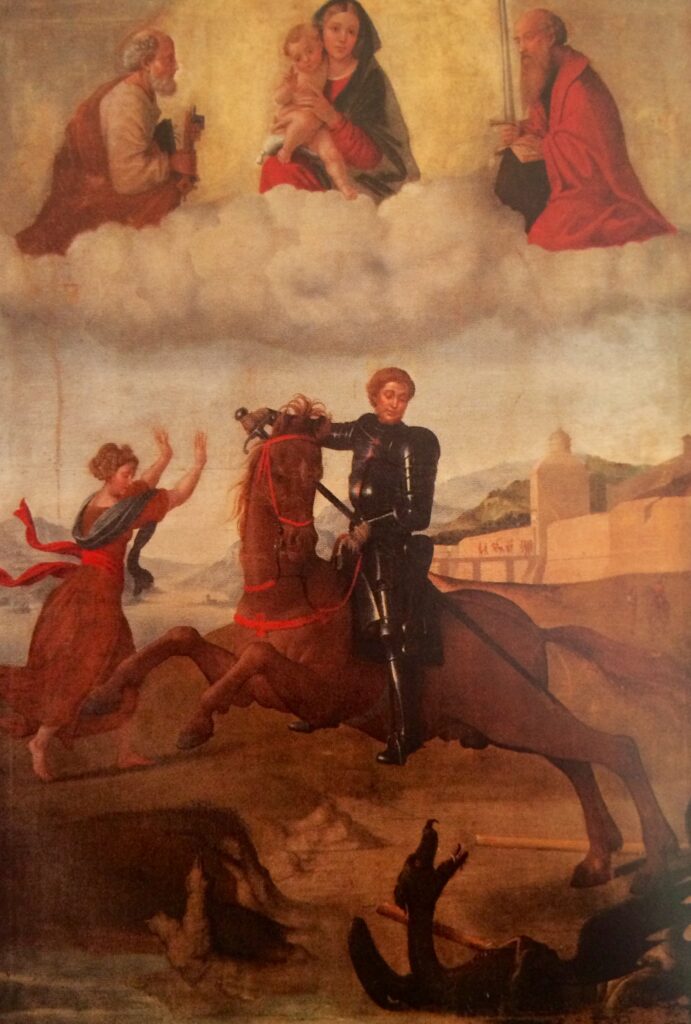
Style and Inspiration
It is no mystery that the story of Saint George slaying the dragon has been such a popular inspiration for artists over the years, examples can be seen from numerous artists including Paolo Uccello, Vittore Carpaccio, Tintoretto and Peter Paul Rubens to name but a few. The Martyrdom of Saint George however, focuses on a different event in the life of Saint George and one which, surprisingly, is much less publicised. If you ask people to tell you about Saint George, the common response is “he killed the dragon” or “he has a red cross” – far less people will be able to tell you that he was beheaded for refusing to worship idols in favour of Christianity, in an act which led to him being declared a saint by early Christians
There is a great deal of debate when it comes to the life of Saint George but there is at least a common agreement on several aspects of his life. In order to understand this painting more, I feel it is important to understand more about Saint George and the time he lived in:
- Saint George was born around the year 280 AD in Cappadocia, Turkey. He enrolled in the Army of the Roman Empire under the reign of Emperor Diocletian
- George became extremely well respected and quickly rose amongst the ranks on virtue of his valour, strength and military understating
- George lived in a time when Christianity had not yet surfaced as the main religion of the empire and Christians were still persecuted, this would not change until the time of Constantine and the edict of Milan, 313 AD
- Refusing to denounce Christianity, Saint George was imprisoned and tortured. Continuing his refusal, he was executed by beheading on 23 April 303 AD in Lydda, Palestine
Interestingly, there is very little factual information to support the tale of George and the Dragon, which in my opinion may be more of a metaphorical interpretation which has evolved over time
Theme
It is not surprising that a painting for the high altar of the San Giorgio church in Verona is centered around a deeply religious moment in the life of Saint George. The scene depicts the moment where Saint George is acknowledged by the heavens. He looks up to the skies as the winged angel descends with the laurel crown. I would have to say that the main theme within the painting is faith, there may be sub themes running throughout the painting but Veronese has chosen to reflect on the moment where George’s faith has been rewarded after great torment and persecution.
What is interesting to me is that Veronese decided to change the theme away from the original and more popular scene of George and the dragon depicted in the Caroto. As I said earlier I think that the legend of the dragon is more metaphorical with emphasis on good triumphing over evil – there are also suggestions that the dragon is representative of Satan and that George is slaying the dragon in victory for Christianity. My feeling is that Veronese was right to change the theme – it is a shame that the most popular event in life of Saint George is the story about the dragon and not the events which led to his death and ultimately his martyrdom. Just to confirm this, I showed my family the Caroto and the Veronese…all of them identified the Caroto as Saint George slaying the dragon but equally, all of them thought that the Veronese was a painting of Jesus. I appreciate that this says more about them than it does western culture.
Composition
The composition of the Martyrdom of Saint George is extremely elaborate and in true fashion with other works of Veronese. The painting clearly demonstrates many of the traits associated with the works of Veronese and they are all brought together with perfect balance. To make it easier to discuss I am going to split the painting in to a few different sections:
Saint George
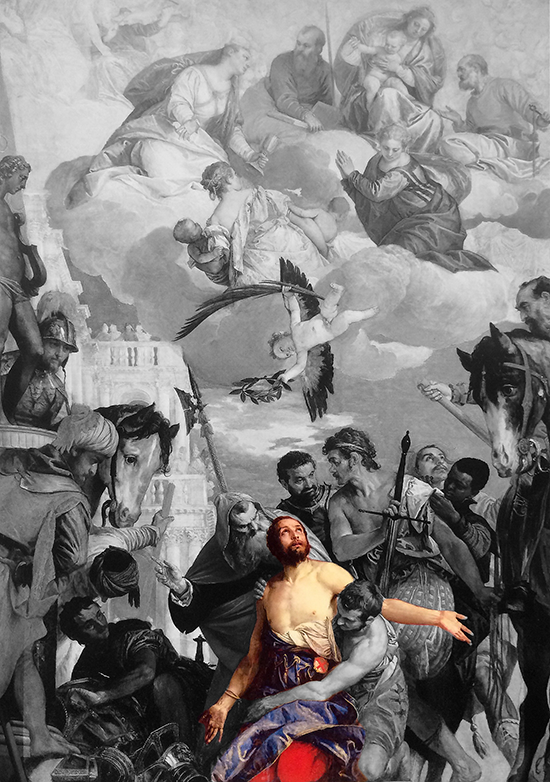
As one would expect, George is the main protagonist of the painting, on his knees looking up to the heavenly figures above. As the story of Saint George goes, he was beheaded for refusing to denounce Christianity and worship Pagan idols. (on the left hand side of the painting we can see the statue of Apollo holding his symbolic lyre) In the scene we can see that George has been stripped of his armour and is being undressed by the two men beneath him. George is being given one last chance to denounce his faith or face execution, with sword in hand he is ready to act. It is important to remember that paintings are mere snapshots in time, much like photographs and if this scene were to go on for a few minutes longer, I am sure we would see the beheading – almost like the calm before the storm we are witnessing the moment where George’s faith is put to it’s greatest test.
The figure of George has been placed at the center of the painting and everything around him seems to lure your eyes on to him. The natural lines of the surrounding figures and their eye lines are all drawing you in towards George. Aside from the lines of the surrounding figures, the tone of George’s skin (use the link at the top to see the full size image) is almost pure white, making him jump right out of the painting. I am sure it is no mistake that his skin tone is closely matching to the heavenly figures above, a clear symbol of his purity and divinity. The expression of George has been painted carefully and he is obviously fixated on the events above, he is not interested in the events unfolding around him which will soon lead to his death. Instead, he is looking up at the angel descending upon him in a gesture which almost speaks to you. For me, I think it is a mixture between “I am yours, take me away” or “I am saved”. The outstretched arms are strongly symbolic of the crucifixion and in truth, there are several parallels which can be drawn between the death of Saint George and Jesus Christ – this may have been something which was intended by Veronese to suit the location of the painting at the high altar. Either way, I guess I can excuse my family for thinking that George was Jesus, even though he is clearly wearing his red cross.
In true style of Veronese, George is adorned with exquisitely painted fabrics with the most intricate detail. Without doubt George is the standout element of the entire painting. When you look at George it is easy to forget that he is about to be executed because there is so much serenity in his appearance, much like George himself, you do not seem to care about what is going on around him and instead just look to the skies as he does.
Each of the figures are pretty much life size and I remember just looking at George for about five minutes in absolute awe of his humility and majesty.
The Priest & The Executioner
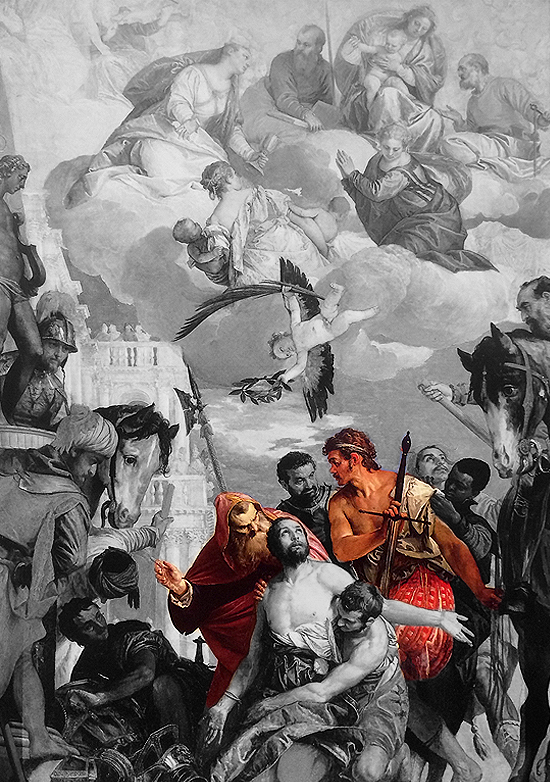
As we move away from Saint George, we are quickly reminded about the horrors which are about to unfold in the painting. The two figures to the left and right of George are particularly interesting and I feel worth commenting on separately…
The priest (hooded figure on the left of George as we look on) has got to be one of the most haunting figures in a painting I have seen. His sharp features and deathly tones combine with his red robes to make him appear almost Satanic. How could anything good come from a man who looks like this. As he tries one last time to make George worship the idol, we can clearly see that there is no commonality between the pagan priest and the to-be saint. If anything, the priest has been painted in this way to once again emphasise the purity and divinity of the Saint
The executioner, like the priest has been painted in a way to promote George as the martyr. He is painted in a slightly distorted way and by no means attractive. As he passes the scabbard of his sword behind him to a servant he looks overcome with a sense of purpose and like a coiled spring, he is ready to explode. As mentioned above, if we forward this scene on a few moments we will witness the executioners huge sword finding its mark. As with the priest, the executioner brings the whole painting back down to earth as we earlier began to transcend the heavens through George.
The Heavens
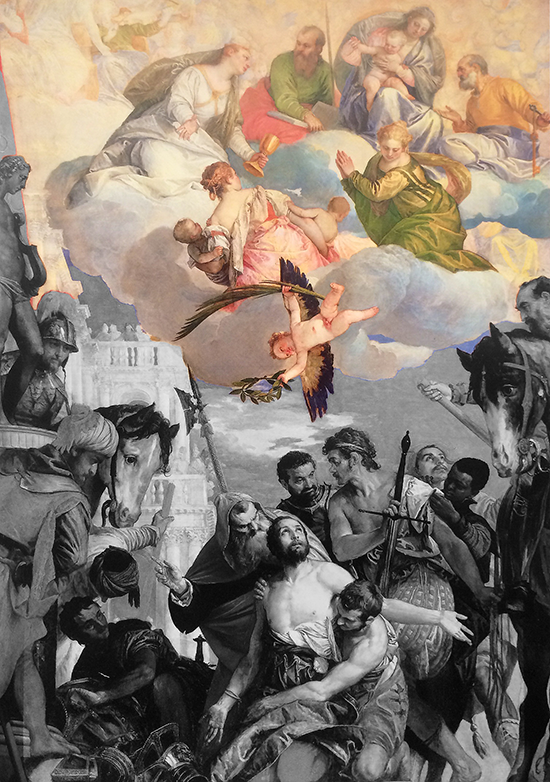
As we look towards the skies of the painting, we are taken away from the events which are transpiring below. From left to right we can see Faith holding the chalice speaking to Saint Paul in his robes of red and green. Beneath Faith we can see Charity providing protection to her children. Moving to the right we can see Hope as she looks down in her robes of green. Above Hope, the Virgin sits with child next to Saint Peter in his classic robes of blue and gold and two keys. The interface between the heavens and earth is the winged angel who holds the laurel crown and palm leaf – the laurel crown symbolises the martyrdom of saint George.
This painting is truly a tale of two halves. Split almost perfectly in the middle, Veronese has managed to paint two scenes which are worlds apart but come together in perfect harmony.
Much like the Caroto painting we can clearly see the heavens above featuring the virgin with child and the two saints. To appreciate the painting then you must imagine it in its rightful home – as you begin to look above the altar you are immediately drawn to George. From there your gaze follows George’s eye line upwards until you reach the heavens – a clear and powerful message to all who view the painting and appropriate for its placement in the church.
The Background
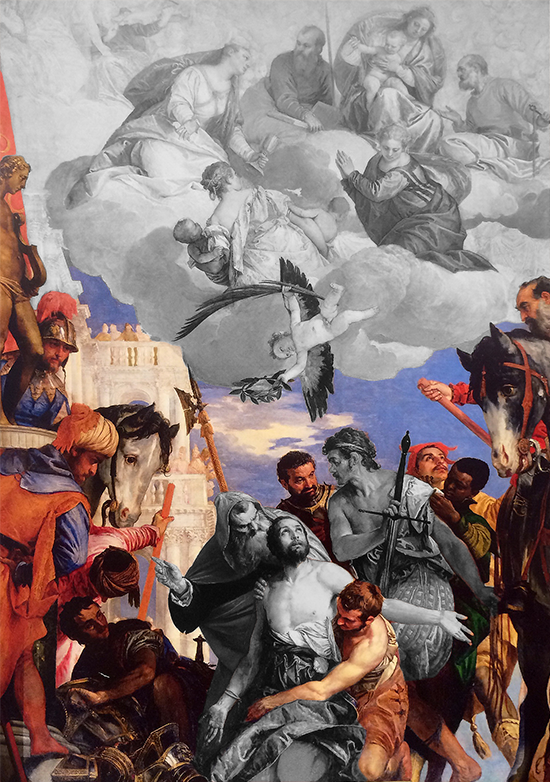
The two men on horseback provide balance to the picture whilst also helping to train your eyes towards George in an almost perfect V-shape. It is hard to say what the other figures are doing but I would suggest that some are preparing for the execution whilst some are trying to give George one last chance to denounce his faith. I think it is important to remember that we are seeing the moment just before the Martyrdom opposed to the actual point itself.
In 1573, Veronese was brought in front of an inquisition to answer for his actions when painting The feast in the house of Levi. He was asked why there were buffoons and Germans at the last super (later changed to Levi to avoid reprisal), he simply stated that “when I have some space left over in a picture I adorn it with figures of my own invention”. This could well be the case with many of the figures in the Saint George.
Final Thoughts
As I stated at the beginning, it would be very hard for me to do this painting justice by presenting a few photographs. What I have tried to do instead is to provide some understanding of the painting, it’s subject matter and maybe a few of my own thoughts and opinions.
I cannot emphasize enough how good the painting is and hopefully you will be so lucky to get the chance to see it as I have. Many thanks for reading this post and I hope you found it useful.